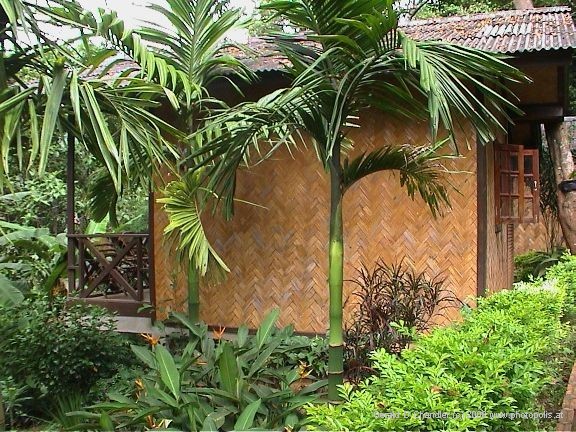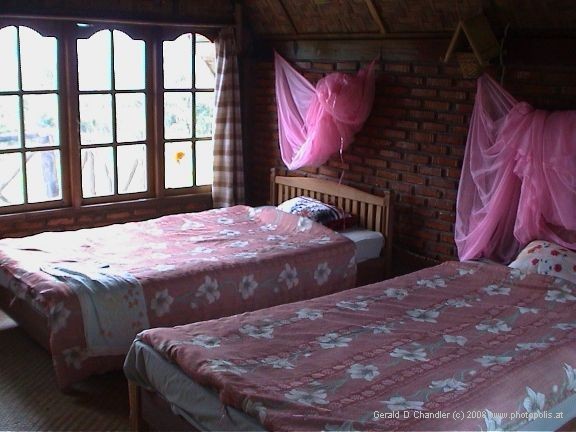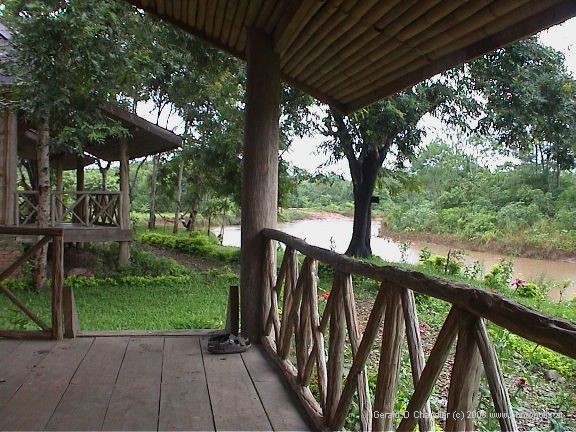Home | Front Page | Blog | Index | New | Contact | Site Map
Ban Sang & Phayao
Poang Salam, Wawi
Chiang Mai
Countryside by Car
Bangkok
Khao Yai NP
Khmer Temples
Ayutthaya
Ancient Capitals
Guest Houses
Medical Care
Foto Show
Other Thailand

Cambodia 2001
China 1999
China 2000
China 2001
Hong Kong 1999
Hong Kong 2000
Laos2001
Thailand 2000
Thailand 2001
Vietnam 2000
Vietnam 2001
Britain 1999
Britain 2000
Britain 2001
Laid back in Laos & Thailand
Lying in bed one day, we heard a gentle slosh slosh slosh accompanied by what sounded like a Swiss cow-bell. In fact it was a Laotian water buffalo grazing in the fallow rice paddies that were just behind our guest cottage at the Adima resort near Muang Sing in Northern Laos. The Adima is one of three country guesthouses that we stayed in in Northern Thailand and Laos that were similar in some ways and yet very different in others.

View from our cabin at Adima resort, Muang Sing, Laos |
Welaxing in the Wawi Valley
Our first guesthouse experience, strangely enough, was in Thailand. We had been staying with relatives near Phayao and were looking for some way to get out into the countryside to do some hiking and perhaps find some tribal villages. In our previous visit in December of 2000, we had come across an ad in Chiang Rai for something called the Swiss-Karen Guesthouse and were hoping to find it or something similar again. We knew we had seen the brochure in an Internet cafe and so on arrival in Chiang Rai we started hunting around. We could hardly believe our luck when we found it in the first place we looked! It was actually called the Karen Guesthouse (email: karenguesthouse@hotmail.com) but it was run by a Swiss-Karen couple (and it was located in the Wawi valley 55 km southwest of Chiang Rai. Quite excited, we tried to call them to book a room and just in case sent them an email. Our attempts to phone failed. It was a mobile phone and seemed to have been switched off. Undeterred, we decided to follow the detailed directions in their brochure and hope to arrive in time to find something else if the place no longer existed or, heaven forbid, was full.
We began by taking a bus from Chiang Rai to Mae Suai and there were to take a "yellow pick-up" for the last 15 kms. As we got off the bus in Mae Suai we were very encouraged to see a bright yellow pick-up bus waiting for us. The driver obligingly helped put our bags on the roof and agreed that we had time to eat lunch, then, as soon as we had sat down, promptly drove away with our bags. Not much we could do and we didnít really think he was stealing them as there were a half dozen passengers in his bus. Sure enough ten minutes later, just as we were finishing our bowl of noodle soup, back he came with the pickup now overflowing with people to squeeze us in.
It must have been market day, because the truck was filled with women and their purchases. There were bags of onions, garlic, chillies, green beans, boxes of canned goods and halfway to our destination, the driver stopped so that all of the women could run into another market and buy some fresh meat. That made Gerry happy too, because he managed to get a cold drink.
After about 45 minutes, the truck stopped and we were motioned to get off. We did, wondering all the while whether we would actually see the guesthouse from the road. When we didnít, we asked someone where it was and they pointed back along the road and there we saw a very nice roofed sign at the end of a side road saying, plain as day, "Karen Guesthouse 200m". So we each put on our backpacks and headed up the road which after 100m made a right turn then after another 100m made a left turn into the grounds of the guesthouse.

Entrance to Karen Guesthouse, Wawi Valley, Thailand |
The first thing we saw was a vine-covered walkway that climbed up a small slope through lush gardens to a building that was mostly hidden. We duly climbed the steps and found ourselves in front of the building that was open sided and thatch-roofed. We could hear voices and could just make out a couple of heads in the center of the room as we unburdened ourselves of backpacks and shoes before climbing the last ten steps up to the building. The floor plan was a kind of cross, with four small bays clustered around a square core. The backmost bay gave access to the kitchens. The two side bays held tables and the front one a low coffee table flanked with bench-type couches.

Karen Cottage, Wawi Valley, Thailand |
The two people, whose voices we heard turned out to be two young American women who, as we later learned, had arrived only an hour before us. A young Thai (or Karen) girl greeted us and said yes, they had rooms available and yes they could show us their best room which was 300 Baht (U.S.$7.50 or 5 British pounds). The room was in fact a detached cottage with its own en-suite bathroom that included an instant gas hot water heater. The cottage was on stilts, had plaited straw walls, and had a small wooden deck that overlooked the lush hillside garden. The deck even had two very comfortable rattan chairs, perfect for just sitting and enjoying the view. We were charmed and immediately took it. We neednít have worried about the place being full. The two Americans and ourselves were the only guests and were to remain so for our entire joint stay of four nights.
Our fellow guests, Keri and Diann, had opted for a cheaper room on the other side of the main building from ours so we all had all of the privacy we could want, although as it turned out we were all pretty sociable and ended up eating almost every meal together. The food was very good. The menu was not very big, but everything we tried from it was delicious. We were especially fond of the banana pancakes. We even ended up spending a couple of days together exploring the surrounding area including the waterfall at Poang Salam and a day visiting tribal villages accompanied by a local school principal, Mr Jesda.
But one of the things that characterized not only this one but all of the country guesthouses that we visited was the pleasure derived from simply sitting still. The conversation corner around the coffee table in the KG main building is where we spent many pleasant hours reading and relaxing with no sounds other than the buzz of insects and the barking of dogs.
The Karen Guesthouse is in the village of Ban Thung Phrao in the Wawi valley. The valley runs from Mae Suai in the south to Thanon and the Mae Ping in the north. Only the southern half of the road that runs through the valley is paved and the hills and valleys on either side of the road are dotted with villages of varying tribes: Akha, Lahu, Lisu, and so on. The yellow pickup runs up the valley and back about once an hour during daylight hours. Oh yes, and unlike in Laos the electricity in Thailand is always on.
Aimless in Adima
We first learned about Adima when we were staying in Luang Prabang. One of the restaurants overlooking the Mekong had a brochure on its wall describing this remote outpost in Luang Nam Tha province. We had also had mixed reports of it from fellow travellers but having just spent two nights in a really dumpy hotel in Luang Nam Tha, our hopes were high as we rode the Adima taxi from the nearby town of Muang Sing to the resort.
The road from town was paved but aging, which meant that the driver had to play dodgems with the potholes. But we were used to bumpy rides, after all we had ridden seven hours to get to Luang Nam Tha three days earlier and three hours to get to Muang Sing this very day. What little of the countryside we could see from the back of the taxi was encouraging. The Muang Sing valley was a very large flat circular valley surrounded on all sides by mountains and planted as far as the eye could see in wet rice. Seven kilometers out of town, the taxi turned right off the paved road onto a dirt road that traversed a small village then forded a stream and pulled into a very large grassy area in front of a large thatch-roofed open sided building.

Adima Cottages, Muang Sing, Laos |
We had arrived at Adima Resort. Although called a "resort", it really is just a guesthouse in the countryside. Once again we were lucky and the best rooms in the house were waiting for us. Our A-frame cottage had windows in front and back and so was very bright even when it was raining. At the back there was a small deck overlooking rice paddies that right then were lying fallow and being used to graze the ownersí water buffalo herd. Sometimes, sitting on the deck in the afternoon when it was shaded from the sun and listening to the slosh, slosh of the buffalo as it chomped around the field and gazing beyond the rice paddies to the mountains beyond it was hard to imagine a more peaceful place. For Jan these are the moments that are most precious: sitting alone in the shade relishing the warmth of the tropical atmosphere, reading a good book, and looking out at a thousand dollar view.

Inside Adima Cottages, Muang Sing, Laos |
As with the Karen Guesthouse, lots of time was spent in the main building where all meals were eaten and where strategically placed hammocks tempted the easily tempted to be lazy. The restaurant area was open on all sides and the views across the valley were stupendous. How fortunate we were. And what a small price we had to pay. The monetary price was 45,000 Kip or about six dollars a night. The comfort price was that this province is one of only two in Laos without a 24-hour electricity supply, so we had to make do with electricity from dusk to 10 p.m. and we had to do without a hot water shower.
We also had to accept that it was the rainy season and that meant lots and lots of rain. By some miracle the day we arrived was bright and sunny all day. But to compensate a lightning storm gathered as evening approached and we had a thunderously good rainstorm that lit up the whole valley in sheets of white light. A small problem in getting electricity in our bungalow meant that on this stormy night we had to each take a cold shower by candlelight before retiring to the sound of the rain on the roof. During the night Jan woke up and noticed that the sound of the rain had been replaced by the sounds of the jungle! Such a cacophony of frogs and cicadas and who knows what other jungle insects!
Laying back in Luang Nam Tha
After four days at Adima, just when we thought we should never want to leave, the daily taxi brought two dozen new guests and we realized that our peaceful haven was gone. We had been privileged to be here at a time when it was exceptionally quiet but that time had ended and so we had to move on. Back we went to Luang Nam Tha.

Jan outside our Boatlanding Guesthouse Cottage, Luang Nam Tha, Laos |
When we arrived at Luang Nam Tha, Gerry quickly found a tuk-tuk to take us to the Boat Landing Guesthouse which, like Adima, is several km out of town. We had seen pictures of it in Luang Prabang, at Adima, and in Luang Nam Thaís eco-tourism office and it looked very like Adima although a little higher priced. Once again we took their best room for 60,000 Kip ($7.50). For that princely sum, we got a stand-alone bungalow with deck and private bathroom overlooking the garden and just beyond it the Nam Tha (river Tha). The bathroom had the usual shower on the floor arrangement but it also had a western toilet and 24-hr hot water thanks to a solar heater. Such luxury! The place is only 1.5 years old, joint owned by a Lao and an American and is definitely a cut above the Adima. The Lao owner told us that in high season (when itís not raining), our room goes for almost double our off-season rate, which comes to only $12!

View of the Nam Tha (Nam river) from our cottage, Luang Nam Tha, Laos |
Our front deck was a favorite place, enhanced as it was with a straw mat and cushions. That meant we could lie there and read very comfortably, which Jan spent many hours doing, watching the muddy Nam Tha rush by and the butterflies visit the flowers in the garden, listening to the pitter patter of the almost constant rain on the bamboo roof and just glorying in the luxury of it.
The restaurant food was good, and equally upscale. We quite enjoyed the set Lao meal which introduced us to some unusual new dishes for us such as green pumpkin soup and a variety of chilli pastes used to flavor the essential sticky rice.
We had plenty of reading matter, if only we had had the visa, we could have stayed there a month. As it was we still wanted to see more of Thailand and get to Angkor Wat in Cambodia. So sadly we said goodbye to our oasis of peace on the banks of the Nam Tha.
Each of these three country guesthouses had its own charm. The site of the Boat Landing Guesthouse with its lovely view, good food and upscale rooms made it perhaps the best of the bunch. But then the remote location of the Adima cheek by jowl with primitive tribal villages and the unsurpassed scenery of the Muang Sing valley are not to be easily discounted. And finally letís not forget the accessibility of the Karen Guesthouse, with its tribal villages, waterfalls, and unspoiled scenery, so near and yet so far from Northern Thailandís urban centers of Chiang Rai and Chiang Mai.